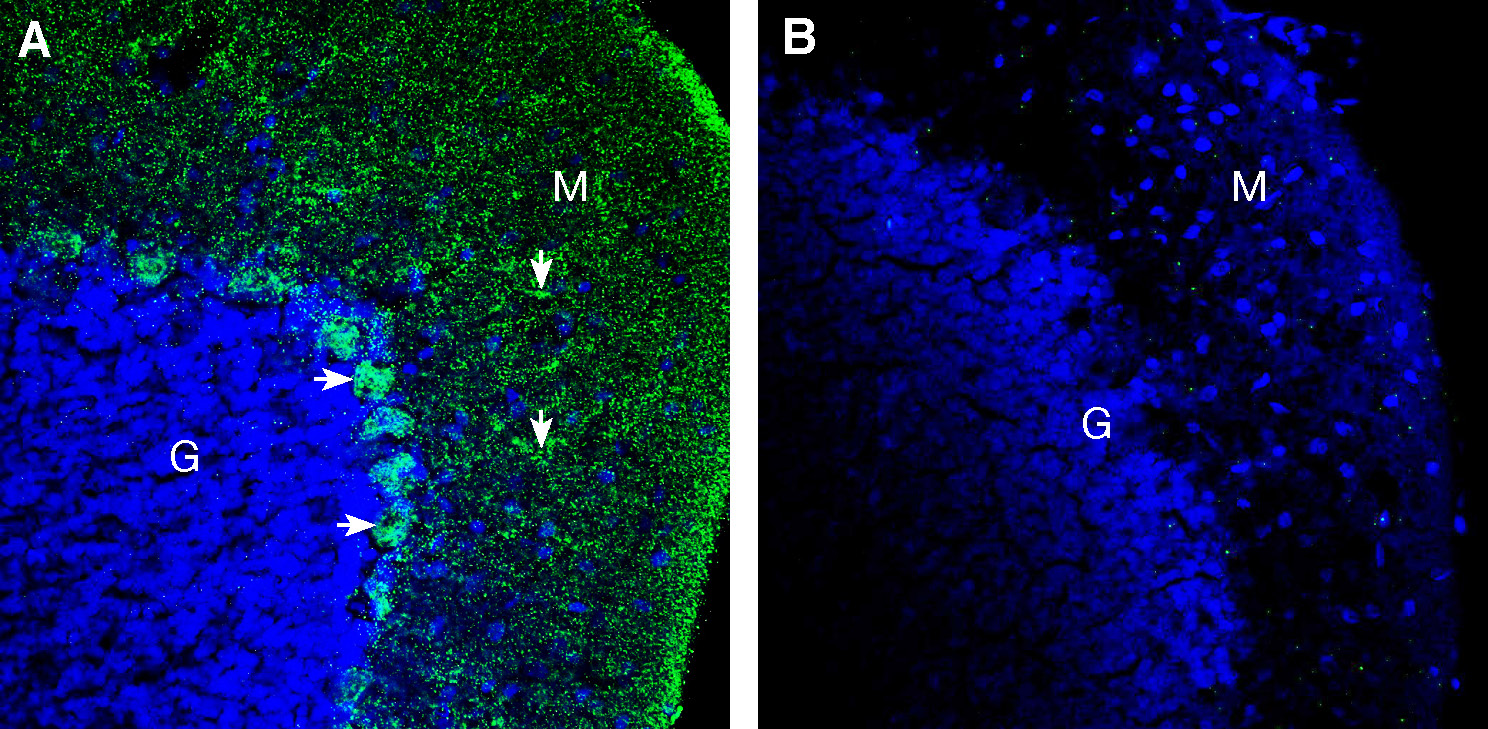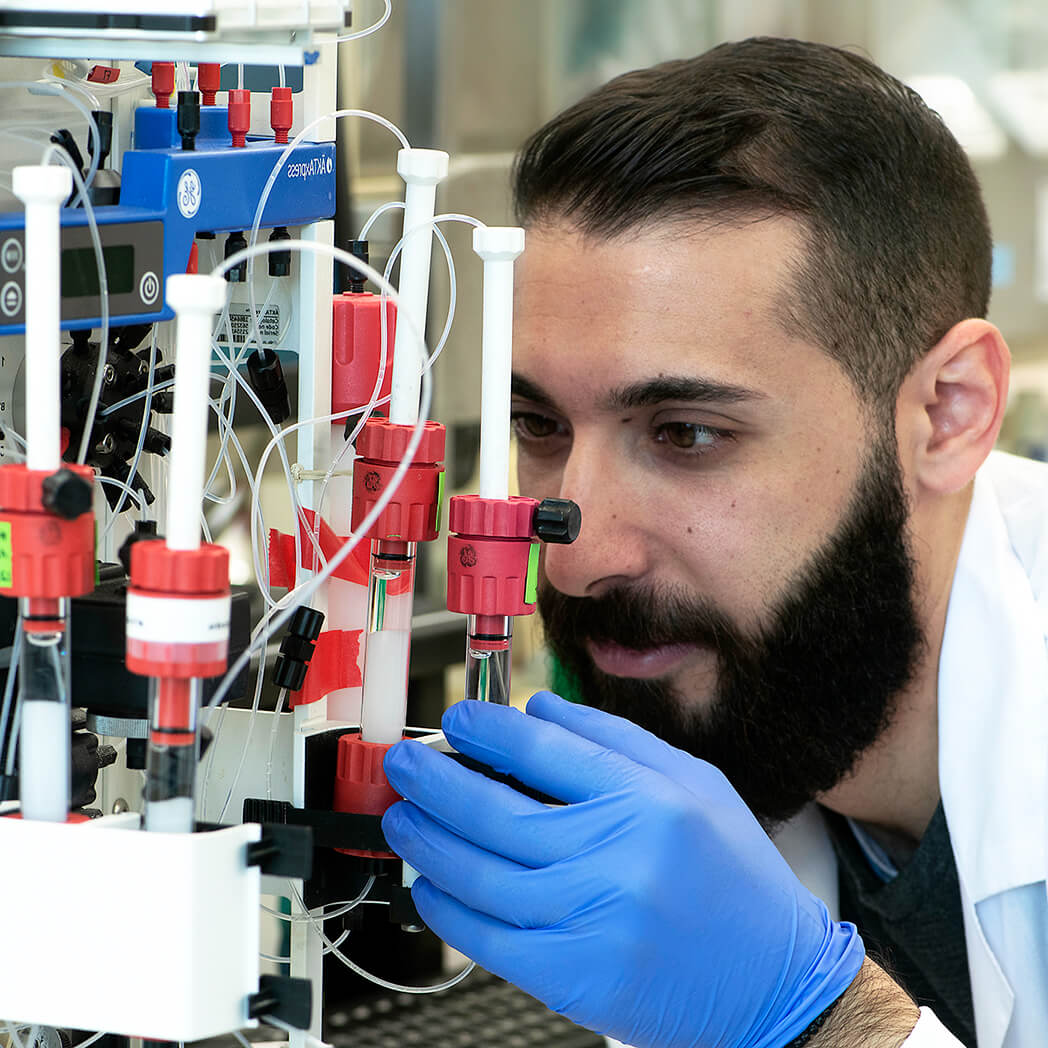Overview
- Peptide (C)EEPIY(S)YTPHNFTRD, corresponding to amino acid residues 76-90 of human PANX2 (Accession Q96RD6). 1st extracellular loop.

 Western blot analysis of rat (lanes 1 and 3) and mouse (lanes 2 and 4) brain lysates:1,2. Anti-Pannexin 2 (extracellular) Antibody (#ACC-232), (1:200).
Western blot analysis of rat (lanes 1 and 3) and mouse (lanes 2 and 4) brain lysates:1,2. Anti-Pannexin 2 (extracellular) Antibody (#ACC-232), (1:200).
3,4. Anti-Pannexin 2 (extracellular) Antibody, preincubated with Pannexin 2 (extracellular) Blocking Peptide (#BLP-CC232).
 Expression of Pannexin 2 in rat cerebellum.Immunohistochemical staining of perfusion-fixed frozen rat brain sections with Anti-Pannexin 2 (extracellular) Antibody (#ACC-232), (1:300), followed by goat anti-rabbit-AlexaFluor-488. A. Pannexin 2 immunoreactivity (green) appears in cells of the purkinje layer (horizontal arrows) and in segments of dendrites (vertical arrows) in the molecular layer (M). B. Pre-incubation of the antibody with Pannexin 2 (extracellular) Blocking Peptide (BLP-CC232), suppressed staining. Cell nuclei are stained with DAPI (blue). G = granule layer; M = molecular layer.
Expression of Pannexin 2 in rat cerebellum.Immunohistochemical staining of perfusion-fixed frozen rat brain sections with Anti-Pannexin 2 (extracellular) Antibody (#ACC-232), (1:300), followed by goat anti-rabbit-AlexaFluor-488. A. Pannexin 2 immunoreactivity (green) appears in cells of the purkinje layer (horizontal arrows) and in segments of dendrites (vertical arrows) in the molecular layer (M). B. Pre-incubation of the antibody with Pannexin 2 (extracellular) Blocking Peptide (BLP-CC232), suppressed staining. Cell nuclei are stained with DAPI (blue). G = granule layer; M = molecular layer. Expression of Pannexin 2 in mouse cerebellum.Immunohistochemical staining of perfusion-fixed frozen mouse brain sections with Anti-Pannexin 2 (extracellular) Antibody (#ACC-232), (1:300), followed by goat anti-rabbit-AlexaFluor-488. A. Pannexin 2 immunoreactivity (green) appears in cells of the purkinje layer (horizontal arrows) and in segments of dendrites (vertical arrows) in the molecular layer (M). B. Pre-incubation of the antibody with Pannexin 2 (extracellular) Blocking Peptide (BLP-CC232), suppressed staining. Cell nuclei are stained with DAPI (blue). G = granule layer; M = molecular layer.
Expression of Pannexin 2 in mouse cerebellum.Immunohistochemical staining of perfusion-fixed frozen mouse brain sections with Anti-Pannexin 2 (extracellular) Antibody (#ACC-232), (1:300), followed by goat anti-rabbit-AlexaFluor-488. A. Pannexin 2 immunoreactivity (green) appears in cells of the purkinje layer (horizontal arrows) and in segments of dendrites (vertical arrows) in the molecular layer (M). B. Pre-incubation of the antibody with Pannexin 2 (extracellular) Blocking Peptide (BLP-CC232), suppressed staining. Cell nuclei are stained with DAPI (blue). G = granule layer; M = molecular layer.
 Expression of Pannexin 2 in human U-87 MG glioblastoma cell lineCell surface detection of Pannexin 2 in live intact human U-87 MG glioblastoma cells. A. Cells were stained with Anti-Pannexin 2 (extracellular) Antibody (#ACC-232), (1:50), followed by goat anti-rabbit-AlexaFluor-594 secondary antibody (red). B. Live view of the cells. C. Merge of A and B.
Expression of Pannexin 2 in human U-87 MG glioblastoma cell lineCell surface detection of Pannexin 2 in live intact human U-87 MG glioblastoma cells. A. Cells were stained with Anti-Pannexin 2 (extracellular) Antibody (#ACC-232), (1:50), followed by goat anti-rabbit-AlexaFluor-594 secondary antibody (red). B. Live view of the cells. C. Merge of A and B.
- Chew, S.S. et al. (2010) Exp. Neurol. 225, 250.
- Nakagawa, S. et al. (2010) Curr. Opin. Struct. Biol. 20, 423.
- Trexler, E.B. et al. (1996) Proc. Natl. Acad. Sci. U.S.A. 93, 5836.
- Hu, X. et al. (2006) Biophys. J. 90, 140.
- Shestopalov, V.I. and Panchin, Y. (2008) Cell. Mol. Life Sci. 65, 376.
- Unger, V.M. et al. (1999) Science 283, 1176.
- Falk, MM. (2000) Eur. J. Cell. Biol. 79, 564.
- Panchin, Y.V. (2005) J. Exp. Biol. 208, 1415.
- Litvin, O. et al. (2006) J. Cell. Mol. Med. 10, 613.
- Bruzzone, R. et al. (2003) Proc. Natl. Acad. Sci. U.S.A. 100, 13644.
Gap junctions are usually found in clusters and enable intercellular communication by allowing the passage of small molecules between cells1. They play important roles in different biological processes. These include differentiation, cell cycle synchronization, cellular development, neuronal activity and the immune response2-4.
Proteins involved in gap junction formation are composed of four transmembrane domains, two extracellular loops and one intracellular loop and intracellular N- and C-termini5,6. Several consensus cysteine residues are in the extracellular loop and are essential and necessary for intercellular docking of gap junction hemichannels in the opposing cell membrane5-7.
Pannexins (Pannexin 1, Pannexin 2 and Pannexin 3) belong to the superfamily of gap junction proteins. Pannexin 1 (PANX1) is ubiquitously expressed, Pannexin 2 (PANX2) is specifically expressed in the human brain and widespread in rodents and Pannexin 3 (PANX3) is also detected in the brain8.
The gating properties of Pannexins were studied in Xenopus oocytes and results demonstrate that only PANX1 is able to form homomeric hemichannels, and is also able to form heteromeric hemichannels with PANX2 but not with PANX39,10. Not surprising, PANX1 gating properties depend whether it forms homomeric or heteromeric hemichannels.
A number of different stimuli are known to open these channels and include mechanical stress, extracellular ATP, increases in intracellular Ca2+ and inflammation9.
Possible roles for Pannexins include paracrine signaling in vascular endothelial cells and taste cell signaling9.
Application key:
Species reactivity key:
Anti-Pannexin 2 (extracellular) Antibody (#ACC-232) is a highly specific antibody directed against an epitope of the human protein. The antibody can be used in western blot and immunocytochemistry applications. It has been designed to recognize PANX2 from rat, mouse, and human samples.
